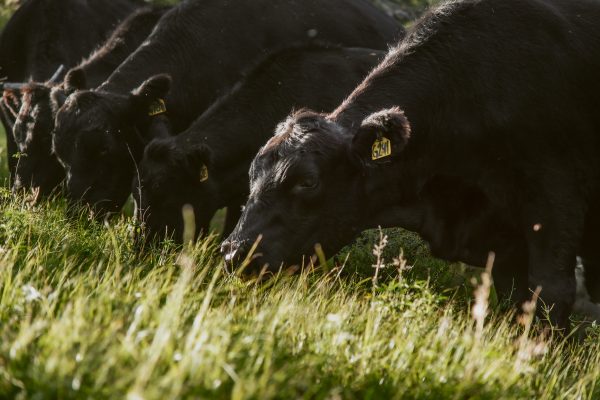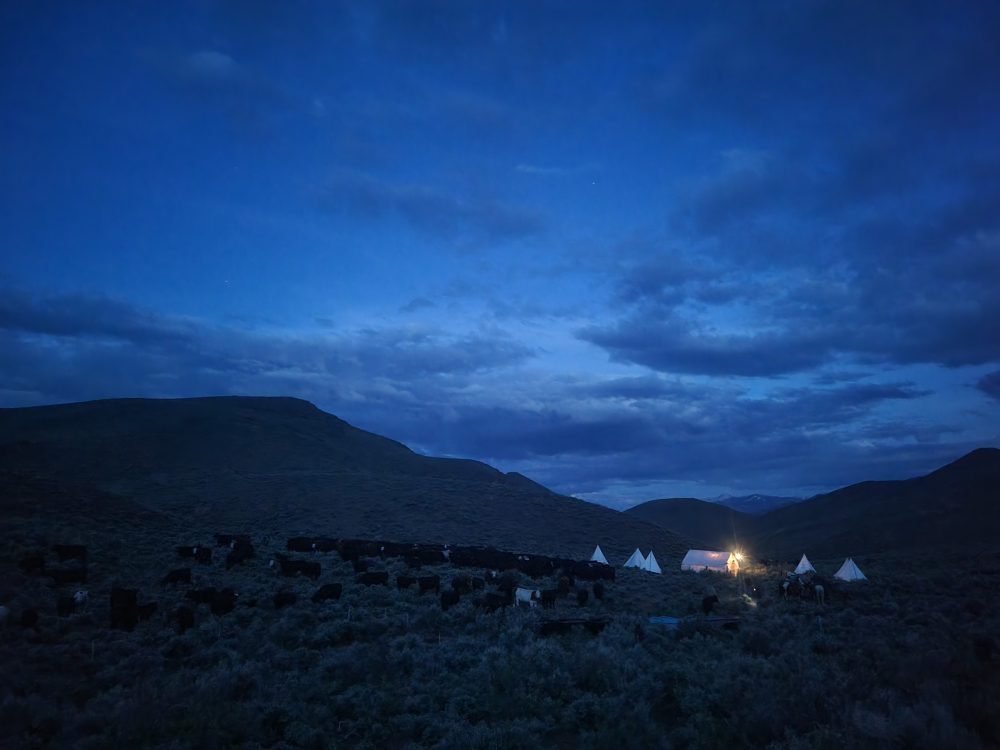
The quiet war fought on Alderspring reached epic proportions this week. Because of the unusual amounts of summer moisture and June heat, it has been a perfect storm of weed invasion. Weed seeds that had long lay dormant in the seedbank germinated and emerged to manifest their presence in places where we had never seen them before.
Our team, consisting of our older daughters (good for character building) and recommissioned cowboys, traded in saddles and horses for 4 wheelers and grub hoes for a full frontal assault. Strategic meetings on Alderspring’s grazing range with federal and county weed forces yielded a unified decision: we would have to unleash our secret weapon: the Cyphocleonus, or purple death beetle (we call them Cyphos for short).
We fight this fight every year.The weed war is probably Alderspring’s largest expense in maintaining our organic certification. The ranch is probably one of the largest certified organic ranches in the country (if not the largest) with 70 square miles under organic certification. Most of that extensive land area is a pristine landscape, meaning that the plants growing there are virtually unchanged since the time that Columbus landed in the West Indies.
Weed invasion is going to change that, however, and measures to prevent spread are required by state and federal mandates. In other words, county and federal agencies will spray chemicals to control them if we don’t demonstrate that we have our own aggressive weed management strategy. Each year, we publish an extensive weed management plan to inform our agency partners, organic certifiers and county weed control personnel what we are doing. Are we winning? Too early to tell, but indeed, with fresh news from the front, we are holding our own.
Weeds, or “invasive non-native plants,” started their colonization of North America with the Pilgrims at Plymouth Rock in 1620. Seeds came on board ship ballast or with European hay and animal feed. They piggybacked in animal’s guts, in the form of seed. Even a settler’s clothing carried on it “sticky beggar tick” Velcro-like seeds. Unbeknownst to him, while he ventured across the New World, the pioneer was likely the Johnny Appleseed of weed spread. One of Caryl’s ethnobotany books said that Native Americans called dandelions “white man’s footprint.” These new plants had no natural predators like the native flora had. As a result, they rapidly colonized and spread like wildfire across the eastern seaboard. The barrier of the dry Great Plains just east of the Rockies put a stop to spread, and as a result, some of the wild parts of the West are still relatively weed free.
The weed that gets the most attention from us in employment of countermeasures is the innocent looking purple-flowered Spotted Knapweed. A nice dairyman introduced it to western Washington in the 1800s via a Trojan horse: a bale of alfalfa hay. The rest is a purple haze history of knapweed takeover- rightly termed a takeover because knapweed has its own subversive strategy of complete conquest: release of a chemical known as catechin, a soil sterilant that destroys cells of germinating seeds and competing plant roots.
With the loss of these native plants comes mortality of the soil biota that has relationships with those natives, thus disallowing restoration back to native species even after knapweed is gone. It’s an ecological disaster. Soil stability is lost because knapweed has a weak root network, and now, it’s a homogenous stand because of its strategically placed sterilant that killed all would-be competitors. Rain and snow events can then send our precious soils 900 miles downstream to the mouth of the Columbia in the Pacific Ocean. I’ll bet Mr. Nice Farmer from Washington was oblivious to the unleashing of the terrible chain of events that would eventually unfold when unloading that bale of European hay (what the heck was he doing with European hay anyway?).
In the past few weeks, we have logged over 250 hours pulling, grubbing and whacking weeds. By summer’s end, we will be well over 300 hours. In recent years our fight has been aided dramatically by Cyphocleonus, or purple death beetle. The ¾ inch little dude even looks like a warrior. He’s got armor, and tank-like antennae that bespeak battle ready. They are even a little unsettling to hold in one’s hand, as they look like they could bore a hole right through your palm if they so desired.
This consumer and killer of knapweed was found on the Eurasian steppe in knapweed’s ancient habitat. After some 15 years of testing to see if it would attack any native plants (it did not, and still has not), it was released in the wilds of Montana, where it happily found entire rangelands cloaked with the choking purple of knapweed in bloom.Each Cypho can cost as much as $1 (we’ve released thousands thanks to the BLM who has entrusted us with their care and deployment across the front). There are several target species on our grass ranges, but thankfully, we have vast areas of country where we have never seen a weed. Those areas are still intact native habitat; an uncommon quality even in national parks and wilderness areas.
It turns out that the back of a horse is an excellent place to view plants from while moving beeves across the landscape, and we always cast an eagle eye downward.
You see, if weeds have their way, the nutrition density of our beef gets affected. The integrity and biodiversity of our soils are what make the plants great for the wellness our beeves. Weeds change all that—and the use of chemicals to control them (the government’s preferred solution at all levels)–destroys soil functionality. It is easy to tell where folks have sprayed native rangelands (not ours!) in our area. They have generally lost most, if not all native plants, and unknowingly introduced annual weeds, such as cheatgrass, also from Eurasia, that usually replaces natives plants on disturbed soils.It’s why we have relationships with all the agency folks that manage lands around us. They know not to spray on lands we manage. We have many road and trailside signs that inform the public what is going on our rangelands—so everyone knows where they are, whether they have a spray rig or not. It’s taken us over 10 years to get their
confidence and trust that we are doing our level best.
Yesterday, I strolled across a former knapweed stronghold on Alderspring’s ranges with Ace Hess, the BLM’s weed rep. Ace has the thankless job of trying to deal with weed incursions on nearly 1 million acres. Funding is tough to come by, as indicated by what he names his funding account: “the redhaired bastard stepchild” of government programs.
I reminded Ace about a 100 head release of Cyphos I did there 6 years ago. I remembered the time well, because it was after a jostling night-time 25 mile dirt bike ride with expensive bugs stuffed in a backpack cooler (Cyphos need to be released in the cool of the night to acclimate slowly with the morning rise in temperatures).
“‹
Now, 6 years later, the landscape was no longer purple. Sickly and stunted knapweed was all that marked their former all-dominating monoculture. Occasionally, a native grass was making a stand in spite of the knapweed poison left in the ground. It would take years before the toxin denatured, but we had time. The big wheels of plant restoration move slowly.We randomly dug up 8 knapweed plants. All of them had Cyphos on them, destroying their roots from the inside out. The death beetle was winning, and the purple tide had been stemmed. On this front, we were winning the war on weeds. We cautiously chalked up another victory for Alderspring and their Allies. Here’s to you, Cypho!







Leave a Reply